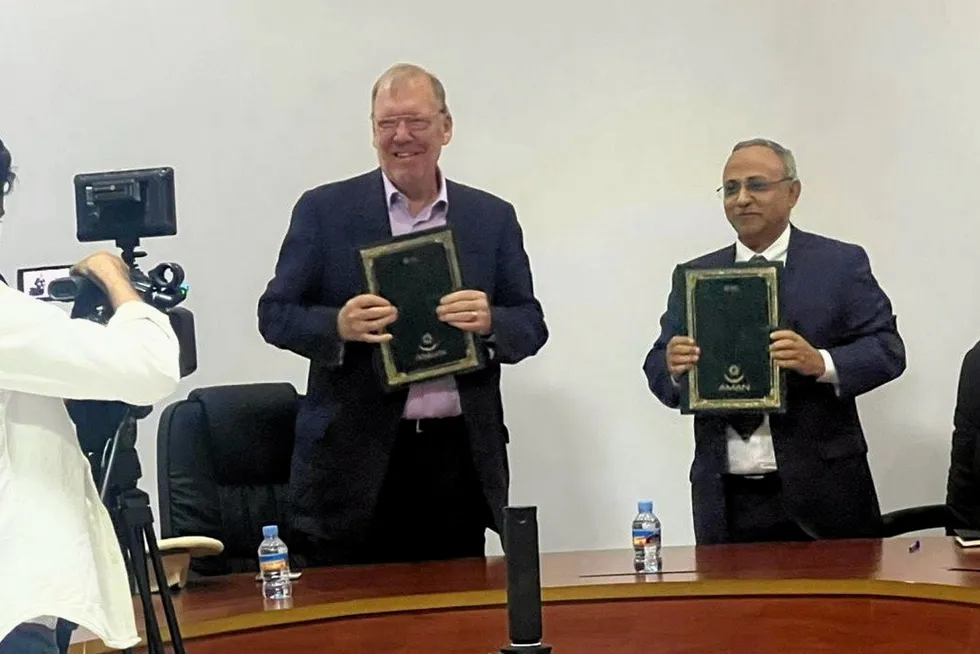The USD 40 billion AMAN project, a collaboration between CWP and the Mauritanian government, aims to include 18 GW of wind capacity and 12 GW of solar capacity.
The facility is expected to produce 110 TWh at full capacity, generating 1.7 million tonnes of green hydrogen or 10 million tonnes of green ammonia annually for both local use and export.
Mauritania is witnessing a surge in green hydrogen projects, including collaborations between Infinity Power Holding and Conjuncta GmbH and Total Eren with Chariot Ltd.
CCO Ramy Lotfy provided an update at an energy conference in Dakar, mentioning over 18 months of wind data collection, advanced environmental studies, and identified potential off-takers.
CWP plans to produce millions of tonnes of green iron for export in Mauritania using hydrogen from 30GW Aman projectGreen H2 developer wants to convert country’s raw iron ore into hot briquetted iron that can help decarbonise Europe’s steel industry

Mark Crandall, co-CEO of CWP Global's hydrogen business, with SNIM CEO Mohamed Vall Mohamed Telmidy at today's signing ceremony.Photo: CWP Global
Editor, Hydrogen Insight
Updated 17 June 2024, 10:47
Green hydrogen developer CWP Global has revealed plans to use H2 from its 30GW Aman project in Mauritania to produce green iron for export to Europe.
CWP’s local subsidiary, Aman Green Energy, has signed a memorandum of understanding with the West African country’s national mining company, Snim (Société Nationale Industrielle et Minière) to collaborate on a potential new hub for direct reduced iron.
The hub would use power, water and hydrogen from the Aman project to convert raw iron ore into millions of tonnes of hot briquetted iron (HBI) — a form of direct reduced iron (DRI) — that would be “mainly” exported to Europe for the production of green steel (see panel below).
Why hydrogen is needed for green iron production
Green steel producers are planning to use green hydrogen to decarbonise their steel mills, which together account for 7-8% of all global carbon emissions.
Traditionally, iron has been extracted from iron-oxide ore by burning carbon-rich coking coal in a blast furnace, where the fossil fuel produces high-temperature heat while simultaneously removing oxygen from the ore by converting it to carbon dioxide.
This highly polluting method can be replaced with green hydrogen in a direct-reduced iron (DRI) facility, where the H2 reacts with the oxygen to produce steam (H2O) rather than carbon dioxide.
In fact, hydrogen-based DRI is currently the only proven pathway of decarbonising steel production, when paired with an electric arc furnace powered by renewable energy.
Policymakers want producers to eliminate emissions from the sector by using green-hydrogen DRI that is then turned into green steel using renewables-powered electric arc furnaces, but with green H2 costing in excess of €5/kg in Europe, it would result in significantly more expensive steel that will require offtakers to pay a premium.
It may therefore be cheaper to produce the green iron in places with stronger winds and sunshine, which would be able to produce cheaper renewable hydrogen.
Show more“The project could pave the way for Mauritania to become a world-leading producer and exporter of green HBI,” says CWP.
In February, European Commission president Ursula von der Leyen visited Mauritania and called for the country to produce its own green iron and steel for export to Europe.
CWP plans to build 30GW of wind and solar power at its Aman project in northwest Mauritania, and recently completed 24 months of resource measurements at its 8,500sq km project site, which confirmed its “outstanding” winds and sunshine.
“The project could produce 1.7 million tonnes of green hydrogen each year, enabling its application to production of various hydrogen derivatives for offtake, including green ammonia (for fertilizers and/or long-range shipping fuel), green DRI/HBI for making green steel products, and/or liquid hydrogen,” the company states.
“CWP aims to have the project FEED-ready [front-end engineering and design] by late 2025 and is working towards first production by the end of the decade.”
SNIM produced and exported about 13 million tonnes of iron ore in the last fiscal year, generating roughly $1.25bn in revenue, and the Mauritanian government plans to increase this to around 30 million tonnes a year over the next decade.
hydrogeninsight.com |





